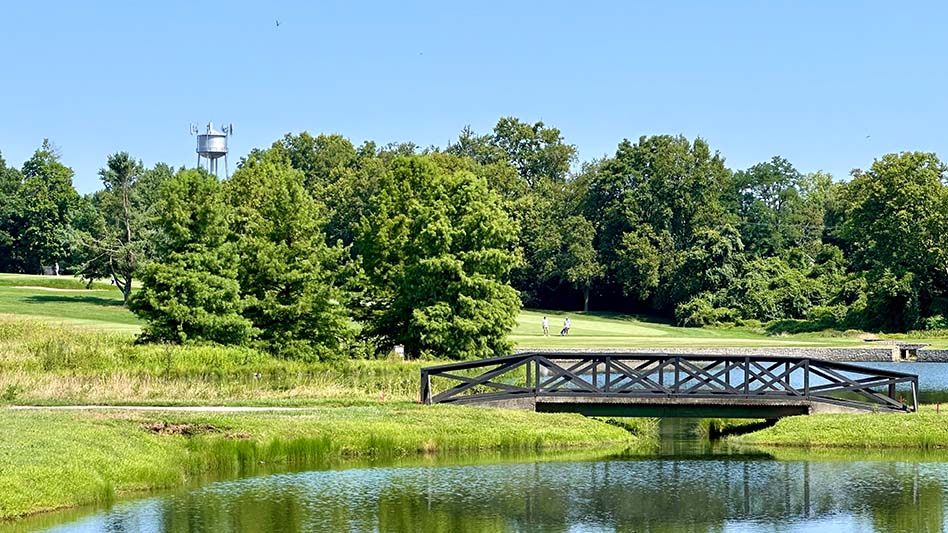
Lee Carr (3)
Great events thrive on three things: a worthy course, outstanding maintenance and a willing host.
Talented players and challenging conditions add to the excitement. Historical significance is created through time like bourbon aging in a barrel. The 118th Southern Amateur Championship at
Idle Hour Country Club in Lexington, Kentucky, had it all.
Mind you, I didn’t intend to write about it. Even as I followed the last group, I wasn’t going to write about it. I was enjoying some July sunshine, unraveling the Donald Ross design, taking photos and trying to think like an architect: landforms, wind direction, degrees of difficulty, water features, high points, drainage, ecology, maintenance, club variety, hole locations, tees, routing and so much more.
But then, the level of golf was electric. More than 150 participants from 14 countries had qualified. The gallery grew and grew. The award ceremony felt intimate and classy. Why, when there are so many golf events hosted every year, did this one feel special?
Maybe it started with tradition and this event being a flagstone in the careers of well-known champions. Bobby Jones won this event three times – 1917, 1920 and 1922. Ben Crenshaw, Justin Leonard, Webb Simpson, Kyle Stanley and Harris English are all Southern Amateur Champions.
Gene Pearce has extensively covered the first 100 years of history of the Southern Golf Association, which governs the Southern Amateur, in a book aptly titled “Southern Golf Association.” The SGA began in 1902 and the Southern Amateur is part of the Elite Amateur Golf Series. This is also the inaugural year for the Elite Amateur Women’s Series.
With several teenagers playing in professional events, the competitive level and undeniable talent of amateur golf is striking. Wenyi Ding, Quinnton Croker and Lance Simpson took first, second and third, respectively, and were a joy to watch. They were polite, respectful and acknowledged the crowd with a grace beyond their years but a sense of fun that felt just right.
They were absolutely striping it and even when they found themselves in trouble, they plotted a way out through mature course management. Some players saw more of the course than others that SGA executive director Andy Priest worked with Idle Hour superintendent Matthew Wharton to set up. Idle Hour golf professional Pete Garvey also contributed significantly and elevated the event to be everything that it was.
None of this is particularly unusual, but there was something about how it all came together. The Southern Amateur has been played on several Ross designs, including the Country Club of Birmingham (Birmingham, Alabama), Holston Hills Country Club (Knoxville, Tennessee) and Pinehurst Resort (Pinehurst, North Carolina). Idle Hour is now part of Southern Amateur history.
Views on the front nine are expansive and pastoral. Red gravel cart paths throughout the property are lovely. There is a double green at two. Off the tees at Nos. 3 and 6, several holes can be seen.

The back nine had a different feel. Don’t miss the green on No. 10. Watch the water on No. 13 and be aware of the burns that wind through the property. Enjoy the rustic bridges. No. 12, named Man O’ War, is the longest hole on the course at 525 yards and No. 18 played the hardest.
Welcoming the players on the first tee and waiting there at the end of the day, was the George W. Adair Memorial trophy, gleaming silver. It is elegant, sturdy, around four feet tall and named after a gentleman who was a benevolent sports enthusiast and closely associated with the legendary Jones. The trophy was first awarded in 1922.
The best thing was watching the crowd grow, reflecting the momentum of the day, as the leaderboard was finalized. The nearer everyone walked to No. 18, the more excitement that could be felt. Ding had pulled away, but the excitement was not just for the golf. Idle Hour had a lot to be proud of.
 From hosting the players, to opening the grounds, to working through the logistics, the conclusion was something to celebrate. The course and the maintenance were the way the SGA intended. That takes planning and communication and execution.
From hosting the players, to opening the grounds, to working through the logistics, the conclusion was something to celebrate. The course and the maintenance were the way the SGA intended. That takes planning and communication and execution.

Members of the maintenance team followed the last group, prepping the course for regular play and taking care of tournament accessories. A Substack post written by Wharton following the tournament noted that fall aerification was seven weeks away. The tournament had finished, but the grind never stops.
It’s worth a break though. For events at the property where you work, or golf tournaments nearby, maybe take the time to look up and breathe deep. Feel the energy as the leaders walk up No. 18. Watch some talented youth and see if you can spot the future professionals. Pick a hometown favorite. Enjoy the golf, appreciate your accomplishments and those of your maintenance colleagues.
Idle Hour made a commitment and hosted a great event. It all came together: a solid Ross design, the maintenance that showcases that design and the people of Idle Hour collaborating with the leaders of the Southern Golf Association. It was a true trifecta – a winning ticket to be remembered.
Lee Carr is a northeast Ohio-based writer and senior Golf Course Industry contributor.
Latest from Golf Course Industry
- Schaffer’s Mill turns to Troon for management
- Talking Turf Weeds 13: Talking seasonal change with Heidi Burgess and Paul Marquardt
- Beyond the Page 65: New faces on the back page
- From the publisher’s pen: New? No way!
- Indiana course upgrades range with synthetic ‘bunkers’
- Monterey Peninsula CC Shore Course renovation almost finished
- KemperSports and Touchstone Golf announce partnership
- PBI-Gordon Company hires marketing manager Jared Hoyle





